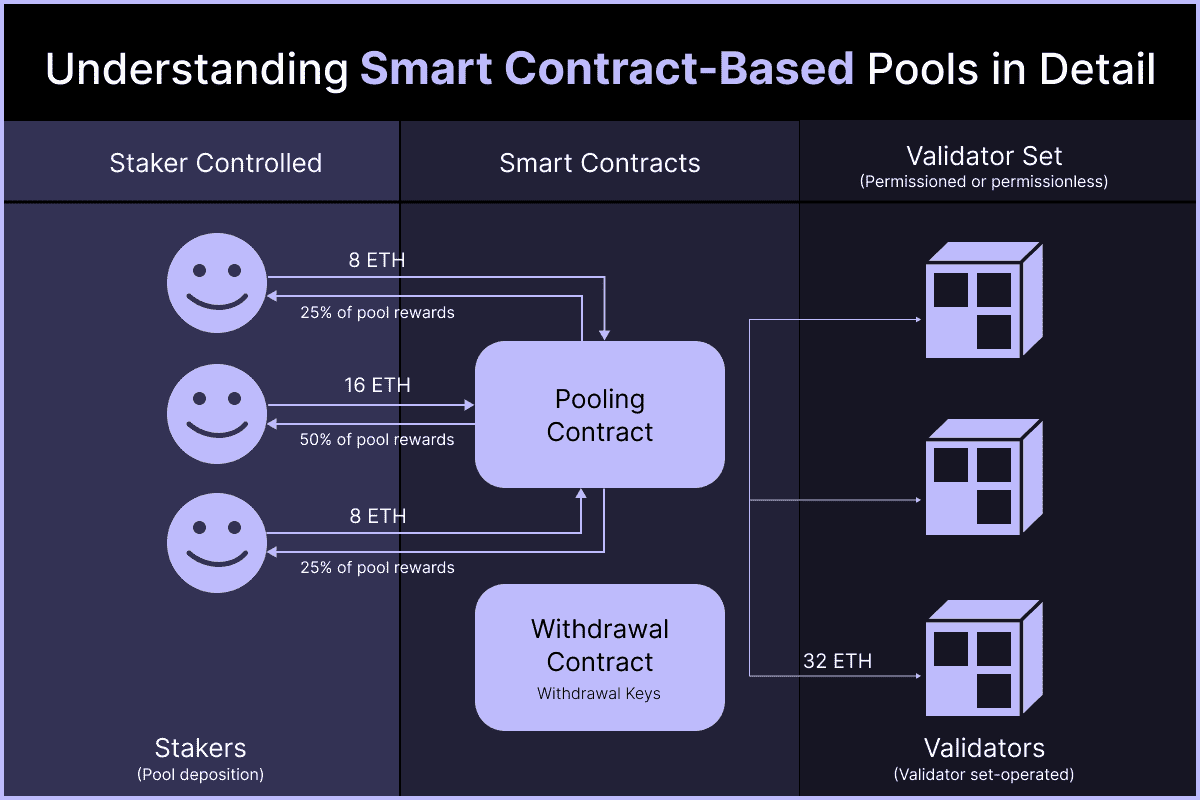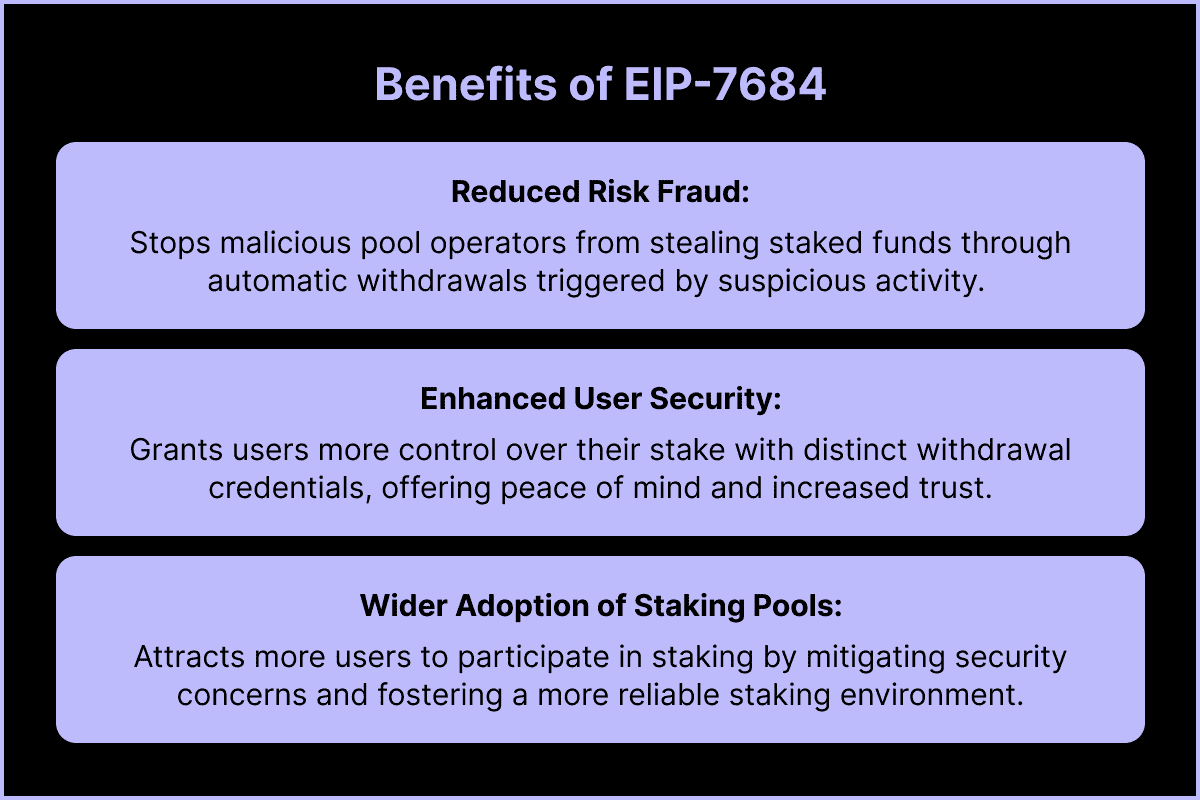SHARE THIS ARTICLE
EIP-7684 Explained: Boosting Security for Ethereum Staking

The Ethereum blockchain relies on a secure and decentralized network function. This security is achieved through a consensus mechanism called Proof-of-Stake (PoS). In PoS, users lock up a portion of their cryptocurrency holdings, known as staking, to participate in the validation of transactions and earn rewards. Validators are responsible for verifying the legitimacy of transactions and adding new blocks to the blockchain. The more tokens staked by a validator, the greater the chance they have of being selected to validate the next block.
Staking has become a popular way for Ethereum users to contribute to network security and earn passive income. However, running a validator node requires specialized software and a significant amount of staked Ethereum, resulting in a high technical and resource barrier. This has led to the development of smart contract-based staking pools as a solution. These pools allow users to combine their stake with others, increasing their chance of participating in validation and earning rewards without the need to manage their own validator node.
While staking pools offer convenience and accessibility, they also introduce a new layer of risk. The security of a staking pool depends on the trustworthiness of the pool operator, who manages the deposited funds. Furthermore, malicious actors can exploit the vulnerabilities to steal user funds from staking pools. A new proposal – EIP-7684 – has been introduced to address these security concerns. The primary aim of this Ethereum Improvement Proposal is to enhance the security for users participating in smart contract-based staking pools.
Understanding Smart Contract-Based Pools in Detail
As mentioned earlier, with Ethereum application development that utilizes PoS consensus mechanism, the chance of a validator being chosen to create the next block is directly proportional to the amount they have staked. For users who don’t possess the technical expertise or a substantial amount of cryptocurrency, participating directly in validation can be challenging.
Smart contract-based staking pools, as a solution to this, function as intermediaries. They allow users to contribute a portion of their ETH to a collective pool. The pool then aggregates these individual stakes and delegates them to validators on behalf of the pool participants.
As a benefit of this pooled approach, users need not run their own validator nodes. Users simply deposit their ETH into the pool and the pool operator handles the technical aspects of staking.
Moreover, the high minimum stake requirements for individual validators become irrelevant with staking pools. Users can contribute any amount of ETH to the pool, allowing broader participation in staking.
By combining the stakes of multiple users, staking pools allow a wider range of users to participate in securing the Ethereum network and earn staking rewards – all without the complexities of managing a validator node.

Security Concerns with Staking Pools
Staking pools offer a convenient entry point for many users. However, unlike staking directly with your own validator node, staking pools introduce a third party – the pool operator – who manages the deposited funds.
Unfortunately, there’s always the possibility that a pool operator might have malicious intentions. A malicious pool operator could exploit vulnerabilities in the pool’s smart contract to steal the deposited ETH from users. These vulnerabilities could be bugs in the code or backdoors intentionally introduced by the operator.
Plus, smart contracts are complex pieces of code and even the most reputable pool can be susceptible to unforeseen vulnerabilities. If a malicious operator identifies such a weakness, they could exploit it to manipulate the pool’s functionalities and siphon off user funds.
Finally, in a worst-case scenario, a pool operator might disappear entirely with the deposited funds. This is known as an “exit scam” and unfortunately has happened in the past within the cryptocurrency space. While reputable pool operators typically have a strong online presence and a proven track record, it’s still a risk to consider.
Understanding EIP-7684
Ethereum's development is a continuous process, with upgrades and improvements proposed through Ethereum Improvement Proposals (EIPs). EIP-7684 is one such proposal. It is designed to address the security concerns surrounding smart contract-based staking pools. EIP-7684 aims to directly address the issue of relying on a third-party pool operator by providing users with greater control over their staked funds.
The core concept behind EIP-7684 is based on “execution withdrawal credentials.” Traditionally, withdrawal credentials have functioned as a key to unlock staked ETH when a user decides to exit a staking pool. However, EIP-7684 proposes a unique approach by introducing distinct execution withdrawal credentials specifically designed for staking pools. These unique credentials play a critical role in improving user security.
Technical Details of EIP-7684
While the concept of distinct execution withdrawal credentials might sound complex, EIP-7684 utilizes them to introduce a powerful security mechanism.
Typically, when a user stakes ETH in a pool, they receive a withdrawal credential. This credential acts like a key that allows them to retrieve their staked ETH when they want to leave the pool. EIP-7684 proposes a new approach. When a user deposits ETH into a staking pool that adheres to EIP-7684, the pool automatically generates a unique execution withdrawal credential for that user's stake. This credential acts as a separate key specifically for withdrawing the staked ETH, independent of any actions by the pool operator.
The key advantage of these distinct credentials is their ability to automatically trigger a withdrawal in case of suspicious activity. EIP-7684 proposes that if a pool operator attempts any action that could potentially jeopardize user funds, the pre-generated execution withdrawal credential would automatically initiate a withdrawal of the user's stake back to their wallet.
This automatic withdrawal functionality serves as a critical safeguard against several attack vectors, particularly those stemming from malicious pool operators. Here are a couple of examples:
-
If a pool operator attempts to disappear with user funds, the automatic withdrawal triggered by the distinct credential would prevent them from stealing the staked ETH.
-
Even in scenarios where a pool operator might exploit a vulnerability to manipulate the pool's functionalities with malicious intent, the automatic withdrawal would still protect user funds with Ethereum wallet integration by returning them to their wallets.
Benefits and Potential Impact of EIP-7684
Benefits
EIP-7684 can significantly improve the security aspect for users participating in smart contract-based staking pools. By introducing automatic withdrawals with distinct execution withdrawal credentials, EIP-7684 offers several key benefits.
-
The most crucial advantage that EIP-7684 offers is it can substantially reduce the risk of malicious pool operators stealing user funds. With automatic withdrawals triggered by suspicious activity, users can have greater peace of mind knowing their staked ETH is protected from potential scams or exploits.
-
The automatic withdrawal functionality acts as a protection against various fraudulent activities. Whether it's a pool operator attempting an exit scam or manipulating the pool for personal gain, EIP-7684's automatic withdrawals can help prevent these scenarios from impacting user funds.
-
By mitigating the risks associated with malicious actors, EIP-7684 can instill greater trust in smart contract-based staking pools. This can lead to wider adoption of staking pools, as users become more confident in the security of their investments.

Potential Impact
The broader impact of EIP-7684 on the Ethereum staking ecosystem could be substantial. By enhancing user trust and confidence, EIP-7684 can incentivize wider participation in staking, ultimately contributing to the security and decentralization of the Ethereum network. It's important to acknowledge that EIP-7684 is still under development, and its final implementation details might differ from the current proposal. However, the core concept holds immense promise for building a more secure and trustworthy environment for users participating in smart contract-based staking pools.
Current Status of EIP-7684 and Future Implications
As of today, EIP-7684 remains in the discussion stage within the Ethereum development process. This means the proposal is undergoing technical evaluations and community discussions to assess its feasibility and potential impact. During this stage, stakeholders, including Ethereum development companies can provide feedback, suggest improvements, and ensure the proposal aligns with the broader goals of the Ethereum protocol. While a firm implementation timeline is yet to be established, ongoing discussions suggest growing interest in the security benefits it offers.
It's important to consider that implementing EIP-7684 might not be without its challenges. One potential consideration is the need for existing staking pools to adapt their smart contracts to accommodate the distinct execution withdrawal credentials. Additionally, ensuring the secure storage and management of these credentials will be crucial.
Moreover, the success of EIP-7684 depends on its adoption by both staking pool operators and users. Widespread adoption will be essential for EIP-7684 to truly make a significant impact on the overall security of staking pools.
Despite these considerations, EIP-7684 represents a significant step forward in securing smart contract-based staking pools on Ethereum. The fact that it can offer users more control over their funds and offsets the security vulnerabilities is a positive development for the entire Ethereum staking ecosystem. As discussions and refinements progress, EIP-7684 has the potential to play a vital role in building a more secure and trustworthy environment for users participating in Ethereum staking.
Post Author

As a distinguished blockchain expert at Codezeros, Paritosh contributes to the company's growth by leveraging his expertise in the field. His forward-thinking mindset and deep industry knowledge position Codezeros at the forefront of blockchain advancements.
Leverage the innovative Ethereum blockchain to build your next dApp.
Ethereum is evolving rapidly to accommodate the improvements. At Codezeros, our expert developers stay informed with the latest developments and assist you with cutting-edge Ethereum application development.



